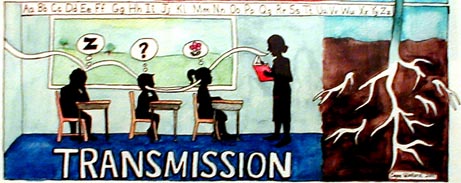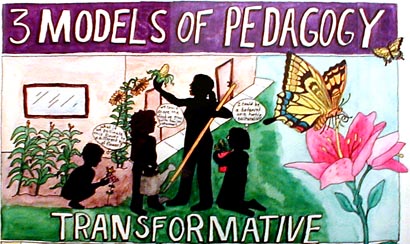Introduction
The watercolor, which is posted below, comes directly from Critical pedagogy: Notes from the real world, 2005, 3/e, pp. 178-180.
It is my pleasure to introduce you to the artist, who created this picture. Dayna L. Watland is a teacher in a private school in Merced, California. When she created this picture, she was a graduate student in one of my classes. If you would like to connect with Dayna, please email me at info@joanwink.com.
The Lesson of Dayna: One Size Does Not Fit All
The lesson of Dayna is as important, as the gift that she created and presented to me on the last night of class. Dayna is unique, as are all learners. She has her own approach to acquiring, generating, and transforming knowledge. She comes from a history of public school experiences that often mandated that she do her assignments in one way, and only one way. The artist in her rebelled. She has painful memories of many of her K-12 years in school. She eventually finished college and received her teaching credential. When I met Dayna, she was preparing to begin teaching and needed a few graduate classes.
For the major writing assignment of this particular graduate class, Dayna surprised and delighted the class and me, when she turned in this representation of her learning.
Enjoy.
Dayna’s explanation of her art follows in her own words.

The Transmission Model of Teaching and Learning

You will notice that the first student has a picture of the subject being taught, but it is not a very realistic picture, as this child does not have the experience to fully understand what the teacher is saying.
The second child has a question, but in this model many questions are not answered because most of the communication is planned and prescribed which ignores the needs of the learners within the class. Please note also that the communication flows in only one direction.
The last child represents the students who have difficulty attending to the lesson.
To the right side of the transmission model are the roots of the plant, which represent the fact that this model of teaching assumes that the planting of knowledge will eventually lead to the generation of knowledge in the learner. This is the model of education that I experienced when I was a student.
The Generative Model of Teaching and Learning

To the side of this picture are the stem and leaves of the plant representing the generative model’s belief that it is not enough just to germinate and sprout, but rather the learner must show growth as well. This is the model that I learned during my student teaching. It is also the model that I tend to practice as a teacher.
The Transformative Model of Teaching and Learning

“What if we pollinate this flower to be a different kind of flower?” one student is wondering aloud. This represents the idea that the transformative model encourages students to create something new with their knowledge.
“We could give some of what we grow to families that need it,” another child says. This represents the fact that transformative pedagogy involves interaction with the community as a whole.
“I could be a botanist or a horticulturist,” the last child muses. This represents the assumption that the transformative model inspires learners to understand how newly-acquired knowledge can transform life and the world.
To the right side of the transformative model is a flower and a butterfly, which represents the idea that even germination and growth are not all there is to pedagogy. In this approach, the teacher and students need to blossom and go out into the world to create something positive for self and social transformation. This is a model I am just beginning to understand. This is my goal for my own teaching and learning.
A final note from Joan:
Thank you, Dayna, for sharing your teaching and learning with us. I think you are a transformative pedagogue.






